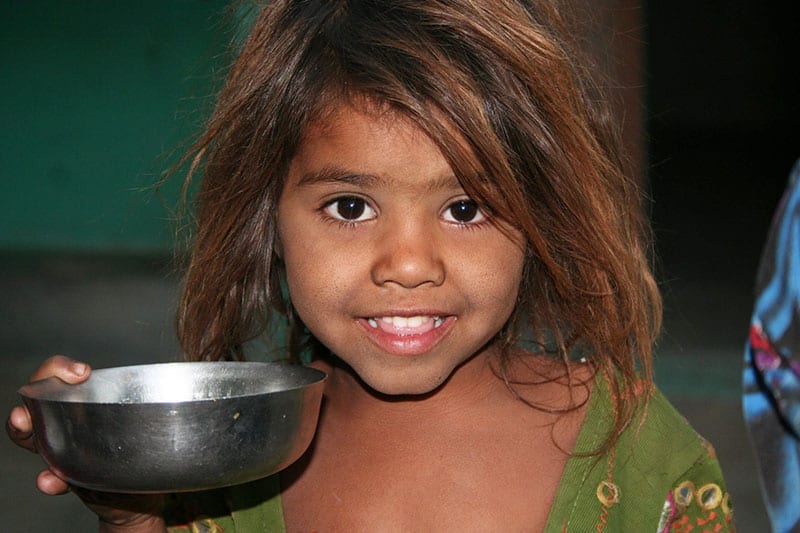Are you looking for meaningful World hunger statistics from scientific studies? Since I have compiled the latest facts and figures for you here, you are in exactly the right place. The right to food is a human right. Nevertheless, the global famine is one of the biggest social problems of our time. The reasons range from the climate changeThe focus here is on a wide range of issues, from natural disasters and poverty to nutrition and food waste in industrialized countries.
In this article you will find the most important facts and figures on world hunger, which you can use, for example, to raise awareness in our society.
Here is another short Table of contents about this statistics article:
Notice: The facts and figures surrounding world hunger sound tough - but fundamentally, the problem is evolving from "serious" to "moderate" according to the World Hunger Index 2019. So, from a global perspective, we are on a good path, even if there are slight regressions in some countries in the meantime. However, environmental problems such as climate change threaten the fundamentally positive development.₁
Facts and figures about hungry people

First of all, I'll give you the numbers on global famine that show who is actually going hungry these days.
How many people are starving?
- Around 821 million people go hungry worldwide. That is 11 percent of the world's population.₂
- Around 2 billion people worldwide suffer from malnutrition.₃
- One in 9 people does not have the minimum required amount of food available.₄
- One in twelve people is a malnourished man or boy, and one in five people worldwide is a malnourished woman or girl.₅
When do people go hungry?
- 1,800 kcal per day are necessary for a healthy life without physical exertion. On average, every German has about 3,500 kcal available per day. That is almost twice as much as necessary.₆
How many children are suffering or dying because of the famine?
- According to UNICEF, 15 percent of all newborns are born underweight. 161 million children under the age of five are underdeveloped as a result of malnutrition. This means that one in four children under the age of five is affected. Over three quarters of these children live in sub-Saharan Africa (39%) and South Asia (38%).₇
- Approximately 3.1 million children under the age of 5 die from hunger each year.₈
- Every 10 seconds, a child dies as a result of hunger. In addition, 45% of all children who die before the age of 5 are due to malnutrition.₉
Where are particularly many people going hungry?
- Around ¾ of all people live in rural regions.₁₀
- Even in industrialized nations, around 16 million people go hungry.₁₁
- The Central African Republic (53.6 out of 100 points), Yemen (45.9), Chad (44.2) and Madagascar (41.5) are ranked as the countries most affected by hunger and malnutrition in the 2019 World Hunger Index.₁₂
- The countries with the largest increases in hungry people from 1990 to 2014 are Swaziland (+57 percent), Iraq (+48 percent), Comoros (+28 percent), and Burundi with +11 percent.₁₃
- Nearly two-thirds of people suffering from hunger live in eight countries: Afghanistan, Ethiopia, Democratic Republic of Congo, Yemen, Nigeria, Sudan, South Sudan and Syria.₁₄
- The largest declines in hungry people from 1990 to 2014 were achieved by Kuwait (-90 percent), Thailand (-77 percent), Vietnam (-76 percent), and Ghana, Mexico, and Venezuela, each with -71 percent.₁₅
- South Asia and Sub-Saharan Africa are the regions with the highest World Hunger Index scores in 2019, at 29.3 and 28.4, respectively.₁₆
Statistics and data on the causes of world hunger
Social problems such as the global famine must be tackled at its root. So here are some facts and figures about the common causes of world hunger.
How much food is wasted?
- Around 1.3 billion tons of food are lost or wasted worldwide every year.₁₇
- 84 percent of Germans who throw away food cited expired shelf life or spoiled goods as the reason. Other reasons include buying too much food (25 percent), product packaging that is too large (19 percent) and products that do not taste good at 16 percent.₁₈
- Every year, 356 million kilograms of meat are thrown away in Germany. 45 million chickens, 4 million pigs and 200,000 cattle therefore die in vain.₁₉
- In rich countries, people waste around 222 million tons per year. By comparison, the total net food production of sub-Saharan Africa is 230 million tons.₂₀
What events promote world hunger?
- Extreme climate events - especially drought - were key triggers of food crises in 23 countries in 2017. Over 39 million people needed urgent assistance in 2017.₂₁
Notice: The list of causes of world hunger is almost endless. Wars, flight, poverty, food prices, trade structures or the need for investment in agriculture are further reasons. Corruption, land grabbing and rising meat consumption are also among them.
To what extent does a meat-free diet help fight world hunger?
- Around 61.8 percent of arable land in Germany is used to grow livestock feed (livestock farming) and only 21 percent is used for direct food production.₂₂
- On average, it takes about seven plant calories to produce one animal calorie.₂₃ So by focusing on plant foods, we could feed significantly more people.
Tip: If you want to see more statistics on meat consumption or veganism, feel free to check out the posts on Veganism numbers and Vegetarianism numbers in.
Statistics on world hunger in the future
Here I give you another important objective of the UN on the subject of world nutrition:
- The UN's plan is to defeat world hunger by 2030 - Zero Hunger. Despite a strong increasing world populationthis is a realistic goal.₂₄
Tip: If you would also like to do your part in the fight against world hunger, please take a look at the sustainable job portal from CareElite. There you'll find a fit with great companies and organizations.
Current studies with facts and figures on world hunger

Looking for more facts and figures on world hunger? Here are some of the most important studies that you can use for your research:
- WORLD HUNGER INDEX 2019, Welthungerhilfe, October 2019.
- GLOBAL REPORT ON FOOD CRISES 2019, FSIN (Food Security Information Network), 2019.
- Women hunger differently - gender justice helps against silent hungerBrot für die Welt - Evangelisches Werk für Diakonie und Entwicklung e.V., 2015.
Notice: The World Hunger Index is published annually and allows you to compare the developments very well..
Using statistics and facts to raise awareness of the problem of world hunger

I hope you find the world hunger statistics you've been looking for here. Be sure to use the facts and figures to spark greater awareness in our society about these global problems like famine. After all, we in Germany are also a partial cause of world hunger by provoking climate change, importing food from poorer countries or wasting it regardless. To solve the problem, just have a look at the following articles:
Do you have questions, suggestions or more facts and figures about world hunger? Then feel free to leave me a comment below this post.
Stay sustainable,

PS.: In the Statistics Blog I have provided many more figures for you in addition to the world hunger facts. For example, take a look at the Plastic waste statistics or the Vegetarian numbers an.
If you use any of the world hunger statistics from this post, please cite the following source. Thank you for your support!
https://www.careelite.de/welthunger-statistiken-fakten/References:
₁ Deutsche Welthungerhilfe e. V. (2019): WELTHUNGER-INDEX 2019: HOW CLIMATE CHANGE IS INCREASING HUNGER, available at https://www.globalhungerindex.org/pdf/de/2019.pdf.
₂,₃,₄,₁₀ Deutsche Welthungerhilfe e.V.: Hunger: prevalence, causes & consequences (as of 04.05.2020). https://t1p.de/ijuj. [07.05.2020].
₅ Brot für die Welt - Evangelisches Werk für Diakonie und Entwicklung e.V. (2015):
Women hunger differently - gender equity helps combat silent hunger, p.3. Available at https://www.brot-fuer-die-welt.de/fileadmin/mediapool/2_Downloads/Fachinformationen/Sonstiges/FrauenHungernAnders-Broschuere-Web.pdf. [11.11.2019].
₆ German Federal Agency for Civic Education (2014): Hunger in the World, Youtube, 02 Dec. 2014, web, 10 Nov. 2019 at 10:03, in: https://www.youtube.com/watch?v=KVLbA06Uh2I.
₇,₉ Aktion gegen den Hunger gGmbH: HUNGER: BACKGROUND AND FACTS (as of May 06, 2019), available at https://www.aktiongegendenhunger.de/hunger. [11.11.2019].
₈ Welthungerhilfe: HUNGER - EXTENSION, DISTRIBUTION, CAUSES - The most frequently asked questions on the topic, available at https://www.welthungerhilfe.de/fileadmin/pictures/publications/de/fact_sheets/topics/2016_factsheet_hunger.pdf. [11.11.2019].
₁₁ Bundeszentrale für politische Bildung (2014): Hunger in der Welt, Youtube, 02.12.2014, web, 10.11.2019 at 10:03, in: https://www.youtube.com/watch?v=KVLbA06Uh2I.
₁₂ Deutsche Welthungerhilfe e. V. (2019): WELTHUNGER-INDEX 2019: HOW CLIMATE CHANGE IS INCREASING HUNGER, available at https://www.globalhungerindex.org/pdf/de/2019.pdf.
₁₃ Statistia GmbH: Countries with the largest increases and decreases in hunger and malnutrition according to the World Hunger Index from 1990 to 2014 (as of October 14, 2014), available at https://de.statista.com/statistik/daten/studie/165572/umfrage/entwicklung-des-welthunger-index-in-den-am-staerksten-von-hunger-betroffenen-laendern. [10.11.2019].
₁₄ Aktion gegen den Hunger gGmbH: HUNGER: BACKGROUND AND FACTS (as of May 06, 2019), available at https://www.aktiongegendenhunger.de/hunger. [11.11.2019].
₁₅ Statistia GmbH: Countries with the largest increases and decreases in hunger and malnutrition according to the World Hunger Index from 1990 to 2014 (as of Oct. 14, 2014), available at https://de.statista.com/statistik/daten/studie/165572/umfrage/entwicklung-des-welthunger-index-in-den-am-staerksten-von-hunger-betroffenen-laendern. [10.11.2019].
₁₆ Deutsche Welthungerhilfe e. V. (2019): WELTHUNGER-INDEX 2019: HOW CLIMATE CHANGE IS INCREASING HUNGER, available at https://www.globalhungerindex.org/pdf/de/2019.pdf.
₁₇ Swedish Institute for Food and Biotechnology (SIK) Gothenburg (2011): Global food losses and food waste, Rome 2011, p.5 (V).
₁₈ Die VERBRAUCHER INITIATIVE e.V.: Lebensmittelmüll in Zahlen, available at http://www.oeko-fair.de/verantwortlich-handeln/lebensmittelverschwendung/lebensmittelverschwendung-in-zahlen. [11.11.2019].
₁₉ Westdeutscher Rundfunk Cologne: Tons of food in the trash? Vomit! https://www1.wdr.de/verbraucher/ernaehrung/rewind-lebensmittelverschwendung-100.html. [07.10.2019].
₂₀ Swedish Institute for Food and Biotechnology (SIK) Gothenburg (2011): Global food losses and food waste, Rome 2011, p.5.
₂₁ Food Security Information Network (FSIN, 2018): Global Report on Food Crisis 2018, p.2.
₂₂ Forum Moderne Landwirtschaft e. V.: Are the animals eating away our grain? (Accessed July 2016). https://www.moderne-landwirtschaft.de/fressen-die-tiere-uns-das-getreide-weg.[09 AUG. 2019].
₂₃ Weick, S.; Brot für die Welt; Evangelisches Werk für Diakonie und Entwicklung e. V.. (2010): Meat consumption (as of March 2010). https://www.brot-fuer-die-welt.de/fileadmin/mediapool/2_Downloads/NIFSA/NIFSA_Kampagnenblatt_Fleischkonsum.pdf. [09.11.2019].
₂₄ United Nations: About the Sustainable Development Goals, available at https://www.un.org/sustainabledevelopment/sustainable-development-goals. [11.11.2019].





